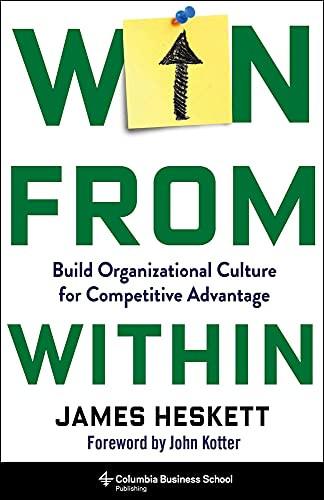Explore the World's Best Ideas
Join today and uncover 100+ curated journeys from 50+ topics. Unlock access to our mobile app with extensive features.
Win from Within
- Evidence does not support most of the common wisdom about organizational culture.
- An effective culture boosts the bottom line, and fosters flexibility, innovation, and learning.
- Leaders must engage and retain employees.
- High-engagement workplaces share several crucial characteristics.
- Experimentation improves your likelihood of success.
- An organization’s policies must reflect its values.
- Remote work presents cultural challenges, but they are not insurmountable.
- When good cultures go bad, change becomes difficult.
- Take 16 steps to change your culture.
19
197 reads
Evidence does not support most of the common wisdom about organizational culture
A strong culture isn’t necessarily a winning asset. Companies with strong cultures can be winners or losers, depending on the culture and the corporate strategy. Forward-looking leaders find culture and strategy complementary.
“When adjusted for industry-related effects of the pandemic [studies] will show that those organizations that put their employees first gained long-term market share and later rewarded their shareholders handsomely.”
The leaders of companies that falter mistakenly often assume that what worked in the past will continue to work. Their leaders resist new ideas.
20
129 reads
An effective culture boosts the bottom line, and fosters flexibility, innovation, and learning
The competitive advantage of an effective culture can outlive that of any strategy. Working only from cultural information, analysts can predict a company’s relative profitability. Using internal and external data, they can estimate how culture affects profit and use that information to motivate cultural change.
“Organizations around the globe are doing a poor job of developing employees who are engaged in their work.”
20
99 reads
Leaders must engage and retain employees
Instead of recognizing an employee of the month, leaders should reward teams over individuals. Recognize employees quietly when they succeed, so that, in effect, recognition becomes part of coaching. Compensation is relevant to engagement, but it’s not the most important factor. In a great culture, employees focus less on pay. This doesn’t mean you can underpay, but rather that culture can be a tiebreaker in engaging talent.
“Organizations with effective cultures can be pressure cookers.”
19
110 reads
High-engagement workplaces share several crucial characteristics
Companies known for highly engaged employees train their recruiters in employee engagement as a competitive advantage. T
In high-engagement workplaces, technology simplifies complex processes and eliminates boring chores. Within prudent limits, employees may act as necessary to get results. Engaged companies recognize their people’s successes. The staff is lean, but the staffers receive reasonable wages.
“Teamwork succeeds or fails depending on the amount of authority and responsibility delegated to the team as well as the extent to which the team is held accountable.”
22
90 reads
Experimentation improves your likelihood of success
Organizations that want to learn from their experiences run frequent experiments and retain the choices that work. Booking.com authorizes any staffer to run a test without advance approval. The company teaches employees how to run experiments, and they do thousands a year. Test evidence overrides executive judgment. Failed tests provide lessons.
“Measurement without action is a great way to scuttle the success of a lot of effort that precedes it.”
19
81 reads
An organization’s policies must reflect its values
Sometimes, a toxic culture has devastating results. After two Boeing 737 MAX planes crashed, a whistleblower said management had rejected an engineer’s request for a safety measure. Employees feared retaliation for bringing problems to management’s attention.
“Results (of surveys) are obtained and discussed with managers and even employees, but little is done about problem areas.”
18
79 reads
Remote work presents cultural challenges, but they are not insurmountable
“The best that leaders of increasingly remote workforces can hope for may be hiring advantages and modest increases in productivity.”
18
81 reads
When good cultures go bad, change becomes difficult
For many years, the Coors Brewing Company distributed beer only in the Western United States. East Coast visitors took Coors home for their friends. The corporate culture reflected Old West mores: Senior executives would even step into the parking lot to settle disagreements with fistfights.
“When it comes to culture change, organizations suffer from attention deficit disorder.”
19
75 reads
Take 16 steps to change your culture
- Leaders acknowledge the need for culture change – Be alert to metrics and to messages from the “shadow culture” that indicate the need for change.
- Use discontent with the status quo as a spur for change – People see change as hard, so you may crystalize their concerns with shifts, such as firing weak leaders, or documenting problems.
- Share the change – Begin and continue a process of ongoing, clear, simple communication. Listen to the reactions. Repeat.
- Designate a change team – Charge the team with codifying values, gathering input, meeting deadlines and maintaining the impetus for change.
19
71 reads
5. Install the best leaders – Bring the right people to the fore; tell the wrong people good-bye. Your goal is alignment around change.
6. Generate and maintain urgency – Culture change should take six to 12 months. As John Doerr said, “Time is the enemy of transformation.” Build in a sense of drive.
7. Draft a culture charter – State which values and behaviors have to change, and how. Draw from your mission, for example, Microsoft spurred change to empower people “to achieve more.” Compare the current state to the desired future.
18
67 reads
8. Promulgate a change statement that involves the whole organization – Communication is crucial. Gather comments; include or reject them; document the outcome.
9. Set up a “monitor team” – This team tracks relevant measurements, checks progress and ensures that communication continues.
10. Align everything – Make sure the changes in your policies and procedures align with your corporate values. Reward what matters.
18
63 reads
11. Put changes into motion – Have leaders pave the way by putting new approaches into action. Leaders must live the change. McKinsey found that change is more than five times likelier when leaders act the way they want their employees to act.
12. Teach people at every level how to implement change – Train managers to train or retrain their employees in new value-based behaviors and processes.
13. Measure new behaviors – Align your metrics with your new expectations. Coach those who can’t adapt and decide whether to retain them.
18
64 reads
14. Acknowledge progress – As you aim for big changes, recognize small victories along the way.
15. Give big changes time to unfold – Seeing the changes in your culture being reflected in customer behavior takes time. Remember you’re inculcating new long-range habits.
16. Keep reminding yourself what culture change requires – This is an ongoing evolution. Leaders must keep checking whether everyone – and every team – understands, prioritizes and communicates about culture change.
18
73 reads
IDEAS CURATED BY
CURATOR'S NOTE
Build Organizational Culture for Competitive Advantage
“
Discover Key Ideas from Books on Similar Topics
6 ideas
The Advantage
Patrick M. Lencioni
13 ideas
Six Pillars of Self-Esteem
Nathaniel Branden
11 ideas
What Your Employees Need and Can't Tell You
Melina Palmer
Read & Learn
20x Faster
without
deepstash
with
deepstash
with
deepstash
Personalized microlearning
—
100+ Learning Journeys
—
Access to 200,000+ ideas
—
Access to the mobile app
—
Unlimited idea saving
—
—
Unlimited history
—
—
Unlimited listening to ideas
—
—
Downloading & offline access
—
—
Supercharge your mind with one idea per day
Enter your email and spend 1 minute every day to learn something new.
I agree to receive email updates

